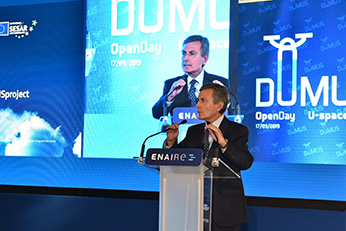Putting multi-service provision to the test
Ensuring drones operate safely alongside all other airspace users calls for advanced conflict detection between flight paths and reliable communications with the air traffic management system. By integrating already developed technologies and concepts around a federated architecture, members of the DOMUS consortium showed that initial and some advanced U-space services, including tactical de- confliction, are possible.
DOMUS demonstrations involved three service providers interacting with one ecosystem manager, and several drone operators using drones from different manufacturers, during tests in Andalucia, Spain. In this approach, the ecosystem manager is the principal U-space service provider and provided data integrity to the system as a single point of truth: Ensuring safety, security, privacy and secrecy, and easing the entrance of new service providers to the system. It also provided the single interface with air traffic management. The service providers operate in parallel to deliver U-space and added value services to the various drone operators, who need to exchange data to carry out their operations. Such data includes optimum operation profiles, fleet management, log records and addition flight information. During the flights conducted by DOMUS partners, three service providers connected to the ecosystem manager and simultaneously
provided services to five different drone operators in close proximity, and at distance, in two different locations: Lugo and Jaen, Spain. In one example, integration with manned aviation was also demonstrated.
Thanks to the ecosystem manager, DOMUS demonstrated some of the initial services detailed in U1 and U2 definitions of U-space, including e-registration, e-identification, geo-fencing, flight planning, tracking, dynamic flight management and interfaces with air traffic control. Some U3 services, such as tactical deconfliction between two drones, and dynamic geofencing – for example around manned aircraft – in collaboration with air traffic management, were also tested. Activities included mapping, normal and urgent deliveries, building inspections and integration of recreational flights. The project also demonstrated the feasibility of connecting U-space operations to the smart city platform.
The live trials showed how a federated architecture can support multiple service providers under the management of an Ecosystem Manager for efficient deployment of U-space services. This is possible using current technology and interoperable U-space services provided by different service providers and different drone operators.
Participants:
ENAIRE
AirMap Deutschland
Sociedad Estatal de Correos y Telégrafos
Centro de Referencia de Investigación, Desarrollo e Innovación ATM, A.I.E. (CRIDA)
Earth Networks
Everis Aeroespacial y Defensa S.L.U.
Fundación Andaluza para el Desarrollo Aeroespacial, (FADA‐CATEC)
FuVeX Civil SL
GMV Aerospace & Defence S.A.U.
Indra Sistemas
Ingenieria Y Economia Del Transporte S. A. (INECO)
Ingeniería de Sistemas para la Defensa de España S.A. S.M.E. M.P. (ISDEFE)
Pildo Consulting
SOTICOL Robotics Systems
Vodafone España.




